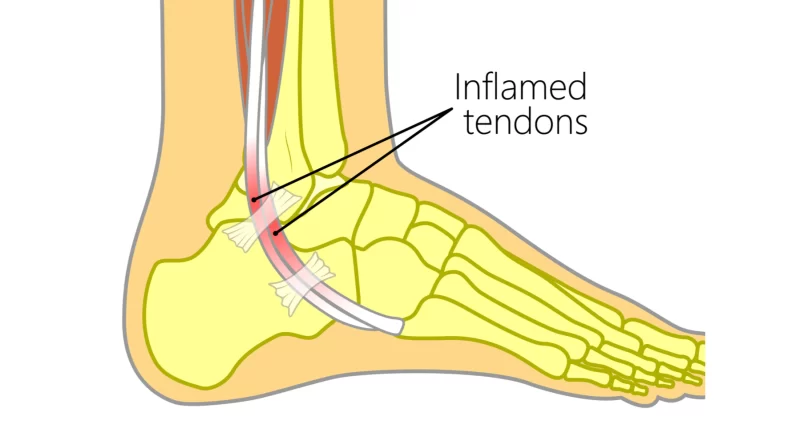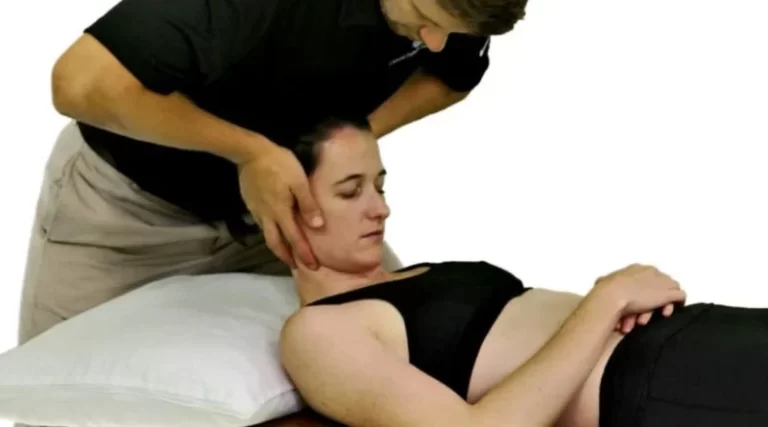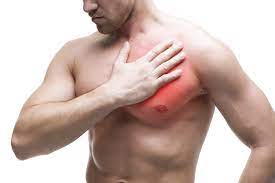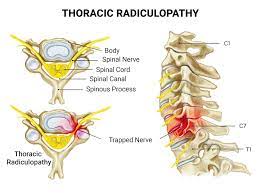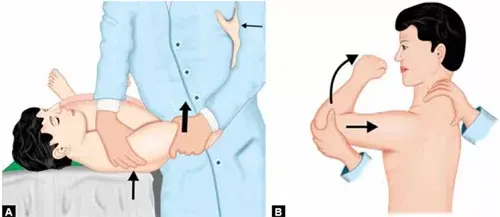Tendinitis
Table of Contents
What is Tendinitis?
Tendinitis is an inflammation in the tendon. Tendon is the thick fibrous cords that attach muscle to the bone. It is also termed tendonitis. It is the connective tissue between muscles and bones. Normally, tendons are flexible yet tough so that they can stretch and withstand tension on it. It can be either acute (short-term) or chronic (long-term) in nature. The condition causes pain and tenderness just above a joint. Due to tendinitis, it is difficult to move the affected joint.
Since the pain of tendinitis occurs near or surrounding a joint, it is sometimes mistaken for arthritis. This condition is more common in adults over the age of 40 and athletes.
Tendinitis can occur in any of the tendons. But it is most common around shoulders, elbows, wrists, hips, knees, Achilles tendon, Base of the thumb, and heels.
Affected Sites:
Tendinitis can occur in any of the tendons. Commonly affected sites are the following:
- Shoulder
- Elbow
- Wrist
- Heel (Achilles tendinitis)
- Hip
- Knee
- Shoulder
- Thumb
What are the Causes of Tendinitis?
Tendinitis can be caused by a sudden injury, repetitive movement, or overuse of joints. Many people develop tendinitis because their jobs or hobbies involve motions that they repeat, over and over. This puts more stress on tendons.
A person may develop tendinitis if they frequently make the same movement while playing sports or working at a job. The risk will increases if you perform the motion incorrectly manner. Moving correctly is especially important when a person has to repeat a movement for sports or a job. Moving incorrectly can increase the load on the tendon and lead to tendinitis.
It can be caused by repeated stress or overuse, which could include:
-Making repetitive motions, such as cutting vegetables or typing on the keyboard for long periods.
-Having poor posture
-Wearing unsupportive shoes
-Excessive exercise
Risk Factors:
Any person can get tendinitis. However, it’s more common in those who do repetitive activities regularly. Some of these activities include:
- Gardening/landscaping
- Cleaning house
- Woodworking or carpentry
- Shoveling
- Painting
- Scrubbing
- Athletes who participate in particular sports, such as running, tennis, golf, skiing, bowling, or basketball(throwing or pitching), are at a higher risk of tendinitis. A person may also be at a higher risk if their job requires physical exertion, overhead lifting, or repetitive motions or tasks.
Other risk factors for tendinitis include:
- Bad posture: Poor posture at work and home or bad walking habits
- Disease: The presence of certain diseases that can make the muscles weak. These diseases can include:
- Rheumatoid arthritis
- Psoriatic arthritic: This is a condition of a combination of a skin disorder (psoriasis) and joint inflammation (arthritis). Most often may notice throbbing pain and stiffness over the tendons of fingers, hands, and toes.
- Thyroid disorder
- Gout/pseudogout
- Blood or kidney diseases
- An abnormal or poorly placed bone or joint (such as length differences in your legs or arthritis in a joint) that may increase stresses on soft-tissue structures.
- Aging: Most commonly seen in adults of 40 years age and older. As tendons in more age, they tolerate less stress, are less elastic, and tear more easily.
- Medications: It occurs rarely that can cause tendons to tear. These medications can include: Fluoroquinolone antibiotics (such as ciprofloxacin and norfloxacin, Statins (drugs that lower cholesterol)
- Repetitive work: Overuse or do too much work too soon when the tendons are not used to making a movement or doing the task taken on. It is common in “weekend warriors,” people that play and exercise hard or only on weekends.
- Infection: It may cause due to an infection, especially an infection from a cat or dog bite to the hand or a finger.
Symptoms of Tendinitis:
Symptoms of tendinitis tend to occur when a tendon attaches to a bone. Symptoms often include:
- Pain: Pain, is often described as a dull ache, especially when moving the affected limb or joint. Pain may present at surrounding joints, such as the tendons, ligaments, and muscles. Pain may be gradual or slow buildup or sudden and severe, especially if calcium deposits are present in the joint. Pain is worse with the movement and usually gets better with rest or treatment. Tendinitis symptoms may re-occur in the same area of the body.
- Pain at night
- Inflammation
- Tenderness
- Stiffness in the morning
- Mild swelling
Diagnosis:
When a patient visits the doctor, a doctor will ask about symptoms and any medical history and perform a physical exam of the affected area. They will also examine your tenderness and range of motion of the affected joint.
The doctor may gently move the affected tendon. The doctor may check tenderness, a creaking sound that happens when the tendon sheath gets thick and inflamed.
Following are some history may present:
- Recent or any past injuries
- Past and present sports or physical activities
- Previously diagnosed medical conditions
- Any drugs are prescripted by a doctor, over-the-counter medications, and herbal supplements you take.
If the doctor can not make a diagnosis after a physical exam or test, they may do additional tests. These could include:
- X-rays: X-rays may show calcium deposits around the tendon.
- MRI scans and Ultrasounds: May reveal swelling of the tendon sheath.
How to Prevent Tendinitis?
To reduce the chance of developing tendinitis or increase inflammation, follow prevention may take:
Ease up: Avoid such activities that place too much stress on tendons, especially standing or staying for long periods in the same place. If you have pain during an exercise, stop exercising and take rest.
Avoid repetitive movements.
Proper position: Learn proper posture positions for all activities.
-Use a firm, but not tightly pressed grip when picking up objects.
-Don’t use one hand to carry heavy objects. Don’t hold the heavy object in one hand at the side of your body, use both hands to carry an object in the center.
-Avoid sitting with your leg folded under.
Mix it up: If one exercise or activity causes pain in a joint, try something another exercise. Cross-training can help you mix high-impact exercises, such as running with lower-impact exercises such as biking or swimming.
Build up intensity gradually.
Take frequent breaks while activity.
Improve mobility: If you are doing an activity or exercise in a flawed manner, you could be setting yourself up for problems with your tendons. Consider taking lessons in position for exercises or getting professional instructions when starting a new sport or using exercise equipment.
Stretch: After doing an exercise, move your joints through a full range of motion. The best time to stretch is after exercise when your muscles are tensed more.
Position your body directly in front of the object that you want to pick up. Reach for the object by stretching your arm and hand directly ahead toward the object. Never grab objects with the arm in a sideways position. If reaching for an object overhead, place the body in the center and reach up and grab the item with both hands.
Move right in the workplace: Make sure your chair, keyboard, and desktop are positioned correctly according to your height, arm length, and the tasks you do. This will help in protecting your joints and tendons from stress.
Prepare your muscles to play: Strengthening the muscles used in your activity or sport can help them to bear the load better.
Proper Wear: Wear properly sized and fitted clothes, and shoes, and use proper equipment.
Treatment of Tendinitis:
The goals of treatment are to relieve pain and decrease irritation. It can be treated by self including rest, ice, and pain relievers might be all that is needed. But the full recovery might take several months or a long time.
First-line treatment includes:
- Avoiding activities that aggravate the condition or problem.
- Resting the injured area completely.
- Keep ice in the area on the day of the injury.
- Taking over-the-counter anti-inflammatory drugs.
Home treatment:

To treat tendinitis at home, use the RICE protocol that includes rest, ice, compression, and elevation. This treatment may help in the speedy recovery and help prevent more complications.
Rest: Avoid doing things or activities that increase pain or swelling. Don’t try to do work or play with the pain. Healing requires rest, but not complete bed rest, just not to keep weight on it. You can do other activities and exercises that do not stress the injured tendon. Swimming and water exercise may be good options for doing exercises.
Ice: To reduce pain, muscle spasms, and swelling, apply ice to the injured area for up to 15-20 minutes 4-5 times a day. Ice packs, ice massages, or baths with ice and cold water, all can help in reducing symptoms. For an ice massage, keep a paper cup full of water in the freezer so that you can hold the cup while applying the ice directly to the skin.
Compression: Compression bandage helps in reduce swelling because swelling can cause loss of motion in an injured joint. Wrap the injured area tightly until the swelling stops. For compression, use wraps or elastic bandages.
Elevation: Elevation helps in reducing swelling. If tendinitis affects your knee or ankle, raise the hurt leg above the level of your heart to reduce swelling.
Although rest is an essential key to treating tendinitis, not moving joints can cause them to become stiffer. After a few days of resting the injured area, slowly move it through its full range of motion to keep your joints flexible and mobile.
Medical Treatment:
Medicines are also used to treat tendinitis include:
Pain relievers: Aspirin, naproxen sodium, ibuprofen, paracetamol or acetaminophen, NSAIDs may help in relieving tendinitis pain. Some of these drugs can cause stomach upset, or kidney or liver complications. Pain relievers in cream form can be applied to the skin. These products can help in relieving pain and avoid the side effects of taking these drugs by mouth.
Steroids: A steroid shot around a tendon might help in easing the pain of tendinitis. These shots are not for tendinitis lasting more than three months. Steroids work quickly to decrease inflammation and pain. Repeated steroid shots can weaken a tendon and increase the risk of tendon tearing.
Platelet-rich plasma: Platelet-rich plasma treatment involves taking a sample of your own blood and pivoting the blood to separate out the platelets and other healing factors. Then this solution is injected into the area of chronic tendon irritation. Though research is still going on it, to find the best way to use platelet-rich plasma, it has been shown in the treatment of many chronic tendon conditions.
Surgical and other procedures:
In situations where physical therapy can not resolve symptoms, your healthcare provider might suggest treatment such as:
Dry needling: This procedure is usually performed with ultrasound to guide it. It involves making small holes in the tendon with a fine needle to stimulate factors that are involved in tendon healing.
Surgery: Depending on the severity of your injury in the tendon, surgical repair may be needed, especially if the tendon has torn away from the bone.
Physical therapy:
Physical therapy is the treatment that helps in treating tendinitis. Exercise can help in strengthening the muscle and tendons. Eccentric(lengthening) strengthening, which emphasizes the contraction of a muscle while it’s lengthening, is an effective treatment for many tendon conditions which is chronic.
Treatment includes:
- Hot/Cold treatment
- Ultrasound Therapy
- LASER treatment
- Hydrotherapy
- Soft tissue and joint mobilization (Manual therapy)
- Orthotics or pressure-relieving devices
- Posture correction
- Range of motion exercises
- Stretching exercises
- Strengthening exercises
- Educate about regarding activities
- Gait pattern and walking
1. Hot/Cold treatment:
Cold treatment includes treatment with ice in acute conditions. An ice pack, ice massage, and cold water are used. It helps in reducing pain and inflammation and swelling. Apply ice for 15-20 minutes two or three times a day.
Hot treatment includes treatment with hot packs for chronic conditions. Place a hot pack on the injured area for 10 minutes to reduce pain.
2. Electric Modalities:
Ultrasound Therapy: Helps in reducing swelling and pain.
LASER: Helps in healing while surgery.
3. Hydrotherapy:
Treatment includes water. Mobility in water reduces the force on muscle to reduce stress on it.
4. Manual therapy: Helps in relieving stress in the injured area.
5. Orthotics or pressure relieving devices: Orthotic devices help in walking. It supports the limbs while walking.
Splints, braces, or slings:– These assistive devices allow the affected area to rest the limb until the pain eases.
6. Range of motion:
Range of motion activities for affected joints.
Initially started with an active movement in the available range.
Later on, passive movement increases range.
As full ROM achieve, start strengthening of joint.
7. Stretching and strengthening:
Stretching of muscles of the affected joint to reduce stiffness and increase flexibility.
8. Education regarding activities:
Educate patient about activities: Teach the patient to walk in a good manner to reduce stress on it.
9. Modification of daily activities and working habits.
Summary:
Tendonitis is a common condition that occurs. It often resolves following a few weeks of rest and basic care. Severe or long-term cases of tendonitis can be disabling and take months of medical treatment and physical therapy to fully recover from it.
The best way to treat tendonitis is:
- Use of the RICE principle
- Over-the-Counter anti-inflammatory medications
- Stretching and strengthening exercises to increase strength
- Surgery may be needed if other methods to treat the condition gets fail, or if you have significant damage to the tendon.
FAQs:
What are the 4 symptoms of tendonitis?
The main symptoms of tendinitis are:
1. Pain and tenderness are present in the affected tendon, which is often worse when you move a limb.
2. Swelling.
3. A grating sensation occurs as the tendon moves.
4. A lump above the tendon.
5. Weakness in the affected area and its surrounding.
6. Decreased range of motion(ROM) of the affected joint.What is the best way to treat tendonitis?
To treat tendinitis at home, use the RICE protocol including rest, ice, compression, and elevation. This treatment can help recover faster and help prevent more complications.
Rest: Avoid doing things/activities that increase pain or swelling.How does tendonitis feel?
One of the main important symptoms of tendinitis is pain at the site of the tendon and surrounding area. Pain may be a slow buildup or sudden and severe, especially if calcium deposits are present.
What causes tendonitis to get worse?
There is a weakness in the muscle or one of the surrounding muscles, lots of muscle tension, and a history of repetitive movement under load. All of these affect each other and one will cause the other to get worse.
Is walking good for tendonitis?
Yes, walking plays an important part in your rehab and recovery from tendinopathy, but there are some factors to consider. If you overdo walking, it can actually make conditions worse.

